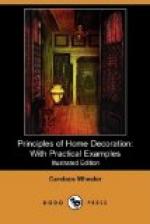It is well to reiterate that the use to which a room is put must always govern its furnishing and in a measure its colour, and that whatever we put in it must be placed there because it is appropriate to that use, and because it is needed for completeness. It is misapplication which makes much of what is called “artistic furnishing” ridiculous. An old-fashioned brass preserving-kettle and a linen or wool spinning-wheel are in place and appropriate pieces of furnishing for a studio; the one for colour, and the other for form, and because also they may serve as models; but they are sadly out of place in a modern city house, or even in the parlour of a country cottage.
We all recognise the fact that a room carefully furnished in one style makes a oneness of impression; whereas if things are brought together heterogeneously, even if each separate thing is selected for its own special virtue and beauty, the feeling of enjoyment will be far less complete.
There is a certain kinship in pieces of furniture made or originated at the same period and fashioned by a prevailing sentiment of beauty, which makes them harmonious when brought together; and if our minds are in sympathy with that period and style of expression, it becomes a great pleasure to use it as a means of expression for ourselves. Whatever appeals to us as the best or most beautiful thought in manufacture we have a right to adopt, but we should study to understand the circumstances of its production, in order to do justice to it and ourselves, since style is evolved from surrounding influences. It would seem also that its periods and origin should not be too far removed from the interests and ways of our own time, and incongruous with it, because it would be impossible to carry an utterly foreign period or method of thought into all the intimacies of domestic life. The fad of furnishing different rooms in different periods of art, and in the fashion of nations and peoples whose lives are totally dissimilar, may easily be carried too far, and the spirit of home, and even of beauty, be lost. Of course this applies to small, and not to grand houses, which are always exceptions to the purely domestic idea.
There are many reasons why one should be in sympathy with what is called the “colonial craze”; not only because colonial days are a part of our history, but because colonial furniture and decorations were derived directly from the best period of English art. Its original designers were masters who made standards in architectural and pictorial as well as household art. The Adams brothers, to whom many of the best forms of the period are referable, were great architects as well as great designers. Even so distinguished a painter as Hogarth delighted in composing symmetrical forms for furniture, and preached persistently the beauty of curved instead of rectangular lines. It was, in fact, a period in which superior minds expressed themselves in material forms, when Flaxman,




